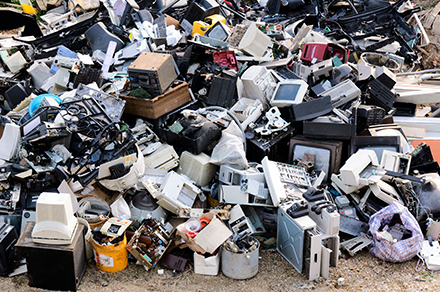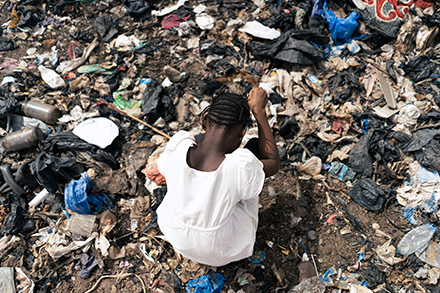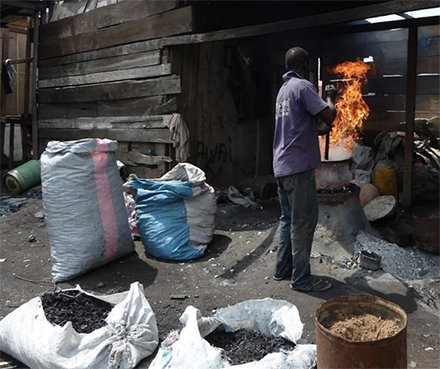By Lauren Sprouse

Electronic waste, or e-waste, is the fastest growing global solid waste stream, posing particular health concerns in low- and middle-income countries that lack the capacity to appropriately handle large amounts of these materials.
Each year, the world generates more than 50 million tons of e-waste - around 16 pounds per person - and technological advances and consumer habits are leading to increased e-waste production. In the U.S. and Europe, for example, the average mobile phone is disposed of in less than two years . Much of the e-waste produced by high-income countries ends up in informal waste sites in Africa, Asia, and Latin America.
Scavenging for e-waste is an increasingly common source of income for those who live near unmanaged landfills. Workers use informal processing techniques, like open burning and acid leaching, to extract precious metals. These practices expose workers - including women and children - to a variety of hazardous compounds.
"Contaminants generated by e-waste include heavy metals, like lead and arsenic, as well as toxic byproducts of plastic processing," said Julius Fobil, Dr.P.H., a professor of environmental health at the University of Ghana. "These pollutants are harmful to many organ systems and are known to cause acute and chronic health effects, including respiratory problems, neurologic and developmental disorders, and cancers."
According to Fobil, the populations at greatest risk of exposure to e-waste contaminants include the recovery workers who directly inhale smoke from fires, as well as the community members who live nearby.
Dangers to Children at Agbogbloshie

The settlement at Agbogbloshie in Accra, Ghana, is home to one of the world's largest e-waste dumping sites, where children as young as 5 years of age work to sort and dismantle electronic materials. Even if they are not involved in recycling themselves, children who live near the site may be exposed to chemicals through air pollution or contaminated drinking water.
Because their bodies are still developing, and they take in higher levels of pollutants relative to their body size than adults, children may be particularly susceptible to adverse health effects.
"Children who work in e-waste recycling often perform dangerous tasks without using protective equipment," said Brittany Trottier, M.P.H., a health specialist in the NIEHS Superfund Research Program and co-lead for e-waste in the NIEHS World Health Organization (WHO) Collaborating Centre. "Younger children often use behaviors like hand-mouth and hand-object, so those who live near e-waste sites are more likely to be exposed to substances released from the e-waste recycling process than adults."
E-Waste and Air Pollution
In 2015, the NIH Fogarty International Center - in collaboration with NIEHS, the National Cancer Institute, the National Institute on Aging, and the NIH Office of Research on Women's Health - issued the first awards to establish Global Environmental and Occupational Health (GEOHealth) centers. The West Africa GEOHealth hub , led by Fobil, aimed to evaluate connections between e-waste sites, poor air quality, and observed health effects.
Fobil and team documented extremely high concentrations of particulate matter near combustion sites at Agbogbloshie, with levels more than triple the WHO air quality guidelines . However, the researchers noted that vehicle traffic and biomass burning for cooking in the surrounding communities may also contribute to particulate matter emissions.

In a follow-up study geared to more specifically evaluate e-waste exposures, the team measured volatile organic compounds (VOCs) - air pollutants specific to e-waste burning at the site - and assessed their health risks. They found an increased risk of cancer due to VOC exposures, primarily attributable to benzene and naphthalene. These chemicals have also been associated with liver damage, neurological problems, and reproductive effects.
"Future research will focus on the effects of e-waste air pollution on kidney function, the endocrine system, and DNA," Fobil said. "Clean, safe e-waste recycling that does not generate products that harm environmental health is the overall goal."
NIEHS E-Waste Focus
NIEHS activities related to e-waste involve disseminating information about the harms associated with e-waste, as well as supporting ongoing research to protect public health.
A published commentary and an open online course about the health effects of e-waste are a few of the communication or educational products NIEHS has helped develop.
NIEHS is also a member organization of the global network of WHO Collaborating Centres for Children's Environmental Health. According to Trottier, the network is particularly interested in e-waste.
In 2021, with technical assistance and subject matter expertise from NIEHS, the WHO published a report detailing the links between informal e-waste recycling activities and health outcomes in children. The report provides a comprehensive overview of the pathways of e-waste exposure and associated health effects. It also provides a way forward for health and policy sectors around the globe to respond to e-waste and informal recycling practices.
"By building successful partnerships, like the Children's Environmental Health network, NIEHS can promote children's health issues with a more global message," said Trottier. "These collaborations allow us to combine knowledge and skillsets to tackle the complex problems associated with e-waste."
References
Kwarteng L, Baiden EA, Fobil J, Arko-Mensah J, Robins T, Batterman S. 2020. Air quality impacts at an e-waste site in Ghana using flexible, moderate-cost and quality-assured measurements. Geohealth 4(8):e2020GH000247. [ Full Text ]
Lin N, Kwarteng L, Godwin C, Warner S, Robins T, Arko-Mensah J, Fobil JN, Batterman S. 2021. Airborne volatile organic compounds at an e-waste site in Ghana: Source apportionment, exposure and health risks. J Hazard Mater 419:126353. [ Full Text ]


